In my last post about Tianwen-1, I explained how on 2021-02-23 the spacecraft would enter an orbit with a period of 2 Mars sidereal days. This would give a repeating ground track with periapsis passages over the intended landing site in Utopia Planitia. Almost one month has passed since then and AMSAT-DL has continued to receive telemetry state vectors every day with the Bochum 20 meter antenna. This data allows us to study the orbit in detail, including orbit perturbations and any station-keeping manoeuvres that are done to maintain the orbit. This post is my first analysis of the current orbit.
Tag: tianwen
Tianwen-1 phasing orbit
Last Saturday 2021-02-20 at 11:46:42 UTC Tianwen-1 passed the periapsis of its elliptical polar orbit at Mars and made a retrograde burn to reduce its apoapsis radius. The trajectory planning of the spacecraft can be seen in its Wikipedia page: the spacecraft first arrived into a low inclination elliptical orbit by making a Mars orbit insertion at periapsis, then coasted to apoapsis, where it performed a plane change, and then it arrived at periapsis, performing the manoeuvre described in this post.
Over the next few days the spacecraft should move into a reconnaissance orbit, which is given in Wikipedia to be a 265 x 60000 km orbit (having a period of 2 days) with an inclination of 86.9 degrees. However, the last burn hasn’t lowered the apoapsis that much. The current orbit is approximately 280 x 84600 km (3.45 day period) with an inclination of 87.7 degrees. A possible reason for using the current orbit, which has been described as a phasing orbit, will be explained in this post after reviewing the data we have about the burn.
Tianwen-1 plane change manoeuvre
Today at 9:00 UTC Tianwen-1 made its plane change manoeuvre, as reported by Xinhua. Yesterday I showed my planning for this manoeuvre. Shortly after the spacecraft returned to the high gain antenna after the manoeuvre, the Bochum 20m antenna operated by AMSAT-DL received state vectors with the new trajectory. These state vectors allow us to calculate the timestamp of the burn and the delta-V vector, as I have done in other occasions. It is convenient to remark that the state vectors that we are seeing right now are probably a prediction. In the next few days we will see updates in the trajectory as the Chinese DSN measures the effects of the actual burn and updates the onboard ephemerides.
Tianwen-1 plane change planning
Today, the Chinese media published a short piece of news stating that tomorrow, 2021-02-15, Tiawen-1 will make make a plane change to a polar orbit. The post is accompanied by an short video, which includes an animation depicting the manoeuvre. A screenshot of the video is shown below. As the spacecraft arrives to apoapsis, it effects a plane change into an ascending polar orbit.
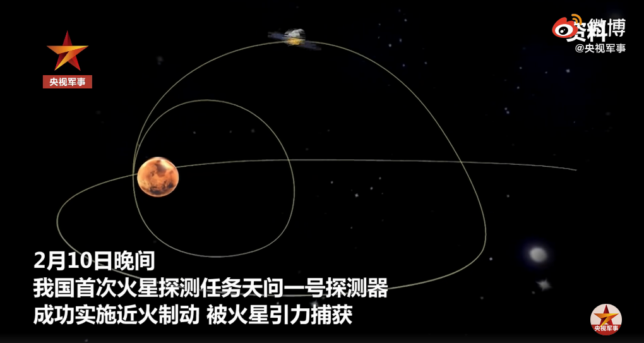
This is a good moment to review the maths behind a plane change manoeuvre and compute what the manoeuvre will look like.
Tianwen-1 Mars-centric state vectors
Since launch, Tianwen-1 has transmitted as part of its telemetry some state vector data, giving its position and velocity vector every 32 seconds. This has allowed us to propagate, track and study its trajectory. We noticed the presence of the state vector data a few hours after launch, and since then we have received and decoded this data using the 20m antenna at Bochum observatory, which is operated by AMSAT-DL. This has allowed us to supply accurate orbit information to JPL HORIZONS, so that Amateur observers (and also some professional ones, for which Tianwen-1 is a useful and strong X-band beacon) can easily get ephemerides for the spacecraft.
Until now, the state vector data has encoded the spacecraft’s Cartesian position (in km) and velocity (in km/s) in a heliocentric reference frame. It is not completely clear if the frame is supposed to be ICRF or MJ2000, since the difference between the two is very small (see Section 3.5 in this paper by Kaplan) to be able to distinguish them with the data at hand, but we have always been using ICRF so far for consistency.
Today we have noticed that starting at some point on 2021-02-08, Tianwen-1 is now transmitting state vectors using a different, Mars-centric frame of reference. We don’t have the exact moment of the change. The last heliocentric vector we received was
2021-02-07 23:23:03.744100 18791639.655712113 211029173.8782428 96492674.05965108 -21.108400067542537 4.768376820024702 1.8445381918644286
This vector was received with one of the antennas at Allen Telescope Array, which I used as a backup since Bochum was unable to track that day due to a big snowfall.
The first Mars-centric state vector was received by Bochum the next day, and is
2021-02-08 22:14:25.049300 -345203.0840200648 103420.7793506239 -15761.456419116437 2.409386271990221 -0.7794198288828312 0.12118319008153547
The change in the frame of reference is clear from the change in magnitude of the position vector. Ensuring that the Mars-centric state vectors are interpreted correctly is important to continue using the data accurately. In this post I give the assessment of the appropriate reference system to use.
Tianwen-1 TCM-4
Today, 2021-02-05 at 12:00 UTC, Tianwen-1 has executed TCM-4. This is its last trajectory correction manoeuvre before the arrival to Mars orbit next Tuesday February 10. This was reported by Chinese media together with a black and white image of Mars taken recently by the spacecraft.
As usual, I have analysed this manoeuvre by propagating forwards the last state vector that we have from the spacecraft’s telemetry before the manoeuvre, propagating backwards the first state vector that we have after the manoeuvre, and finding the intersection point of the two trajectories.
Tianwen-1 TCM3 final trajectory
A few days ago I posted about TCM3, the fourth trajectory correction made by Tianwen-1 so far. After some days, the Chinese DSN has performed precise orbit determination and updated the on-board ephemerides, so that we are now seeing the final trajectory in the telemetry state vectors.
The figure below shows how the state vectors have been updated a couple of times following the TCM, as the DSN computes and uploads an improved trajectory solution. I have plotted this graph in the following way: I have taken the first state vector received after TCM3, on the UTC afternoon of 2020-10-28, and used it to propagate a trajectory in GMAT. The plot shows the difference between the state vectors and the GMAT trajectory.
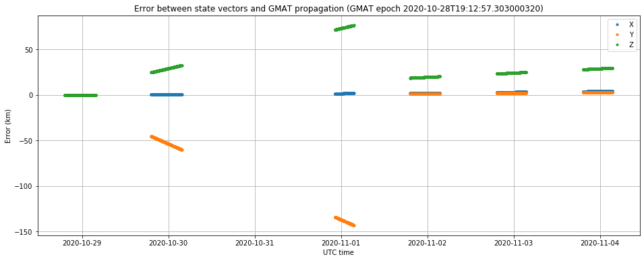
TCM3 happened on 2020-10-28 at 14:00 UTC, so the reference trajectory computed in GMAT corresponds to the trajectory of the state vectors immediately following the TCM. These are based on a prediction of the burn performance, rather than on the actual results. The graph above shows clearly two changes in the trajectory, one on 2020-10-29, and another one on 2020-11-01.
Since we have already seen the same trajectory for three days without updates, I am confident that this trajectory is now final. The latest state vector we have today is
[0163f5396aeb] 2020-11-04 03:25:57.092300 160383830.37880394 94290296.68475787 45404213.83552203 -9.17821106231485 22.96506090856966 10.332601544380973
As always, this gives the UTC timestamp and the ICRF heliocentric position and velocity coordinates in km and km/s respectively.
I have re-run the calculations in the previous post by back-propagating a state vector from the UTC evening of 2020-11-01, which already belongs to the final trajectory. The change in delta-V in comparison to what I should in the previous post is small. The new delta-V is 2.13 m/s rather than 2.09 m/s, and the components have changed around 5%. The detailed calculations and data can be found in the updated Jupyter notebook.
Tianwen-1 TCM3
On 2020-10-28 at 14:00 UTC, Tianwen-1 has made its third trajectory correction manoeuvre. This has been the next manoeuvre after the deep space manoeuvre at the beginning of October. According to the press release, this was a firing of the eight 25N thrusters intended as a minor correction and as a test of this propulsion system. I haven’t found the duration of the burn in the news.
I have followed the same method as in previous burns to compute the moment of the burn and the delta-V vector by extrapolating the telemetry orbit state vectors received by AMSAT-DL in Bochum before and after the burn. This extrapolation locates the burn at 14:02:28 UTC. Note that this time is an approximation for the mid-point of the burn.

The delta-V vector was, in m/s
[-0.6575566 , -0.11513034, 1.97535319],
and the magnitude was 2.09m/s. Assuming a mass of 5000kg and eight 25N thrusters, it would take a burn of 52 seconds to achieve this delta-V.
Update 2020-10-30: according to this news article, the duration of the burn was 42.8 seconds which is some 18% smaller than my estimate. Note that my estimate didn’t take into account the mass of fuel spent by the deep space manoeuvre, which I estimated to be 457kg (giving a decrease in mass of 9%).
Apparently this burn has lowered the periares height significantly in comparison to the trajectory following the deep space manoeuvre, which was around 18000km. Thanks to Achim Vollhardt for noticing this. It’s difficult for me to give a good estimate of the new periares height, because it is quite sensitive to orbit perturbations. I’ve obtained anything between 30 and 800 km by enabling and disabling solar radiation pressure in the GMAT propagator, and we don’t have a good estimate of the spacecraft’s cross-section and reflection coefficient.
The figure below shows one of the GMAT simulations. Note that the periares is near the equator, which is good for insertion into a low inclination orbit.
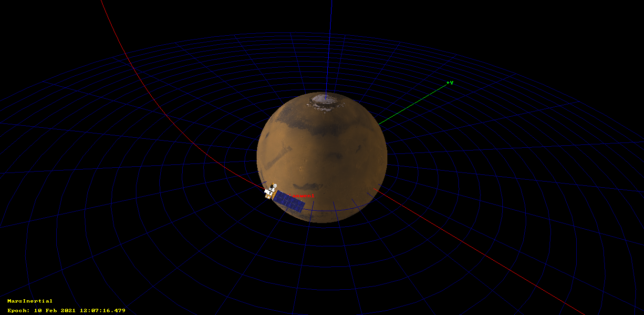
Keep in mind that according to the media still one more trajectory correction manoeuvre remains and that the data used in this post comes straight from the spacecraft’s telemetry, and as such is most likely based on a prediction of the burn rather than on the actual performance of the burn. In a few days, I will publish a new post when the Chinese DSN perform precise orbit determination and upload updated orbital information to the spacecraft.
The data and plots for this post can be found in this Jupyter notebook.
Tianwen-1 attitude change
A month ago, I wrote a post showing the evolution of Tianwen-1‘s attitude so far during its transfer orbit to Mars. For most of the mission, the spacecraft has maintained a fixed attitude where the spacecraft body Y axis was held orthogonal to the planed formed by the spacecraft, Earth and Sun, and the spacecraft to Sun vector had a constant angle of -20 degrees with the spacecraft body X axis.
The figure below shows how the spacecraft axes are labelled. Note the solar panels along the Y axis, the thruster on the -X face, and the high gain antenna on the -Z face.

Yesterday, on 2020-10-22, the spacecraft made an attitude change. The angle between the Sun vector and the X axis was changed back to 0 degrees, which was the angle maintained during the first days of the mission. This can be seen clearly in the figure below.
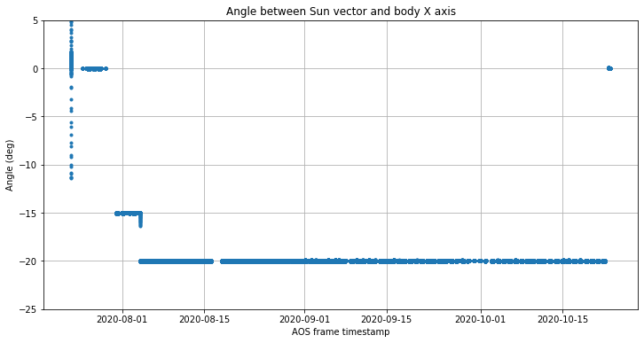
The angle between the Earth vector and the -Z axis (where the high gain antenna is located) is more interesting, as it gives the slew angle of the antenna. Throughout most of the mission, it was growing and I kept wondering if an attitude change would be done to prevent the antenna from running out of slew range. However, at some point the angle started decreasing. This is basically caused by the Earth “overtaking” Tianwen-1, since the Earth’s orbit is faster (you can see some pictures of this in the last slides of my talk in the AMSAT-UK colloquium).
In this graph we see that the change in attitude also causes a sudden increase of 20 degrees in this angle, so now it is 70 degrees. This shows that the possible slew range for the high gain antenna is much larger than I had initially thought. Perhaps it is not so surprising after we have seen the cut-out in the dish in the in-orbit images published on October 1.

If we zoom in to the last few days, we see that the change in attitude happened at some time when the spacecraft was not in view from Europe, so unfortunately we don’t have any telemetry of the change itself.
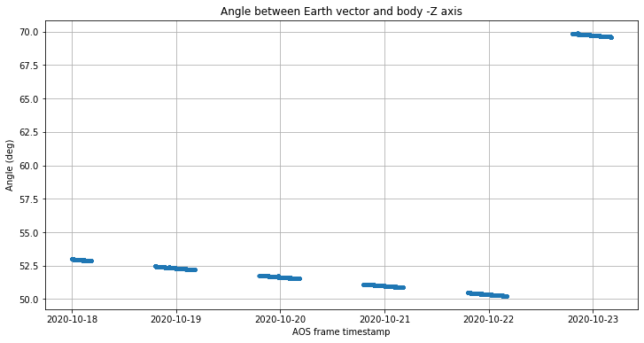
I’m not sure of the reason why this attitude change has been done now. It will be interesting to see if the attitude continues with this new 0 degree angle or it switches back to the previous -20 degree angle.
Thanks to AMSAT-DL‘s team at Bochum for continuing the daily collection of telemetry with the 20m antenna. Their effort makes it possible to detect events like this with short notice. The data and code to produce the plots in this post can be found in this Jupyter notebook.
Tianwen-1 DSM final trajectory
A few days ago I spoke about the deep space manoeuvre that Tianwen-1 had executed on 2020-10-09. As remarked in that post, the data we had from that manoeuvre came from extrapolating state vectors from before and after the burn. The state vectors that the spacecraft was broadcasting after the burn most likely came from a prediction rather than from the actual result of the burn. In a few days, we would see a small change in the trajectory as the Chinese DSN performed precise orbit determination and uploaded the results to the spacecraft.
In fact, we saw that change the next day. The figure below is generated in the following way. I have taken the first state vector that we have received after the burn, and propagated its trajectory in GMAT. Then I compute and plot the error in each of the ICRF coordinates between the state vectors broadcast by the spacecraft in the telemetry and this GMAT trajectory. This allows us to see whether the trajectory broadcast by the spacecraft has changed slightly at some point.
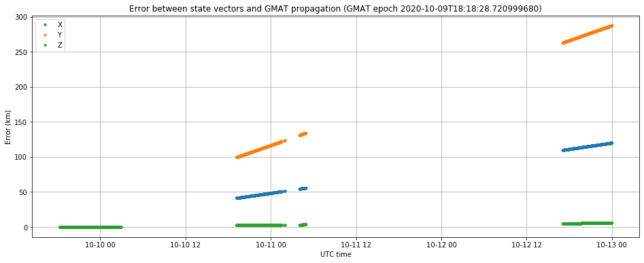
As we can see, during the first day the error is close to zero. Afterwards, the trajectory deviates and the error starts growing to several hundreds of km. The new trajectory seems to be stable over the last few days (sorry about the lack of data on the night between the 11th and 12th). This is best shown in the figure below, where the state vector used as a seed to generate the GMAT trajectory is taken from the UTC evening of 2020-10-10. The error is only a fraction of a km. Therefore, we can consider final this new trajectory.
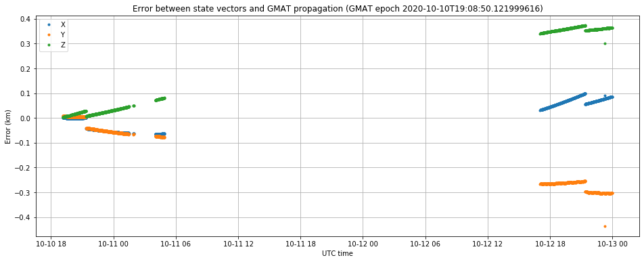
I have updated the calculations I did in the last post to use a state vector from the updated final trajectory. The results don’t change much. The calculations now locate the burn (approximated as an impulse burn) at 15:03:54 UTC with a delta-V of
[-31.08193895, 40.28872314, 308.12845989]
in ICRF coordinates, while my previous calculations estimated a burn at 15:03:59 with a delta-V of
[-31.49477234, 39.29765307, 308.11690616]
The state vector describing the updated post-DSM trajectory in heliocentric ICRF coordinates and UTC epoch is
Tianwen1.Epoch = '10 Oct 2020 19:08:50.122';
Tianwen1.X = 172262669.5024532
Tianwen1.Y = 42536664.64589398
Tianwen1.Z = 21989467.534531824
Tianwen1.VX = -1.7753279668677469
Tianwen1.VY = 25.966616665124505
Tianwen1.VZ = 11.810575717885476